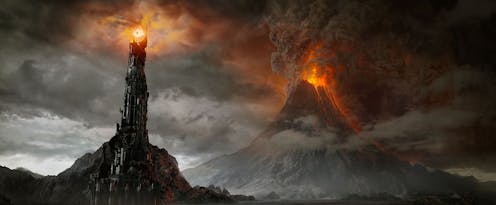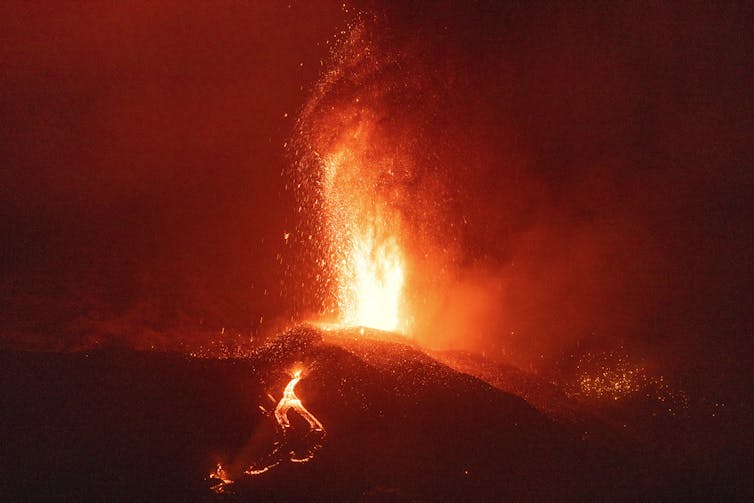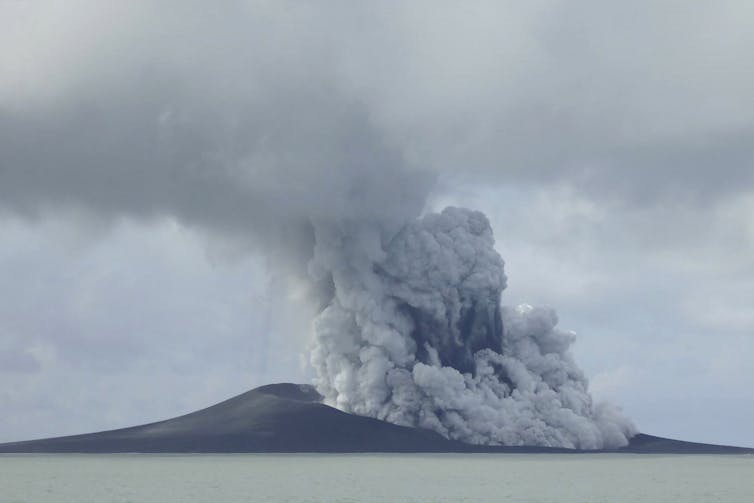
In the blockbuster fantasy series The Lord of the Rings: The Rings of Power, one of the principal antagonists, the wicked Adar, diverted a river into the labyrinth of tunnels under a dormant Mount Doom to trigger an explosive volcanic eruption. This transformed the surrounding landscape into the bleak lands of Mordor – setting up the blighted kingdom of the orcs that features heavily in the Lord of the Rings movies.
The dramatic, and devastating scheme has led to many viewers wondering whether there’s any real science behind this fantasy terraforming plot. Can explosive volcanic eruptions actually be “engineered”?

What exactly is a volcanic eruption?
Volcanoes erupt molten rock, called magma, at temperatures between 700 and 1,300℃. Volcanic eruptions can be effusive, forming lava flows, or explosive, ejecting large fragments of magma and rock, fine ash and volcanic gas into the atmosphere. Mount Doom – or Orodruin – in The Rings of Power, is depicted as spectacularly doing the latter.
Some explosive eruptions are caused by high abundances of volcanic gases in magma. Others, called hydrovolcanic explosive eruptions occur when magma comes in contact with external water – such as groundwater, oceans, lakes, rivers, and glaciers or ice sheets – and superheats it to steam.
The heat energy of the magma is transformed into explosive mechanical energy in the steam as it expands in a process called thermal detonation.
Can a volcano create Mordor?
Many hydrovolcanic explosive eruptions have been witnessed, such as the 1963-1964 Surtsey volcanoin Iceland, the fatal 2019 eruption of Whakaari White Island volcano, New Zealand, and the 2022 Hunga Tonga-Hunga Ha’apai volcano in Tonga.
Experimental simulations of this have been undertaken at the laboratory scale, using small volumes of remelted lava and similar materials.
The theory of hydrovolcanic explosions is based on our understanding of how water acts as a coolant fluid in nuclear and other power stations. In nuclear reactors the radioactive fuel, often uranium, generates heat as it undergoes radioactive decay in the core of the reactor.

This core is surrounded by a water reservoir which is heated by the fuel and converted to steam that drives turbines, generating electricity. If the core overheats, because the coolant water has escaped (potentially due to damage to the containment reservoir), the residual water may become superheated and explode. This happened during the 1986 Chernobyl power station disaster in Ukraine, and the 2011 nuclear disaster in Fukushima, Japan.
To generate maximum explosive intensity during such a fuel-coolant interaction, the ratio of water to fuel (or magma) has to be just right. Research into nuclear explosions indicates the optimum ratio of water to fuel is in the range of 2 to 5, whereas in volcanology it is about 0.1 to 0.3.
If there is too little or too much water, steam is generated but explosions are local and small, and the magma will cool, fracture and solidify.

So, could we really make our own Mordor?
Triggering a hydrovolcanic explosive eruption is not easy. Getting enough water into the magma reservoir of dormant or active volcanoes many kilometres beneath Earth’s surface is impossible because there are no Mount Doom-like tunnels, just highly compressed dense rock.
Volcanoes with an active lava lake in the crater won’t have a river feeding into them because the craters will be perched at the elevated summit of the volcano. And even pouring water onto a lava lake surface would produce a lot of steam, but not necessarily strong explosive eruptions because the water will cause a cooled solid crust to form on the lava surface.
The only substantial hydrovolcanic explosive eruptions have occurred where significant volumes of magma have erupted rapidly up through a body of water such as groundwater, a lake or ocean, and vigorously mixed with it triggering explosive interaction (e.g. Surtsey, Iceland; Hunga Tonga-Hunga Ha’apai, Tonga).
To trigger such a hydrovolcanic explosion, we would need to move a large amount of magma from a reservoir deep within Earth’s crust to the surface, by propagating a huge network of fractures many kilometres deep. This is nigh impossible at the scale required, even using nuclear explosions. So, unfortunately, The Rings of Power’s proposition is just a fantasy.
Read more: Curious Kids: Why do volcanoes erupt?
What would happen to Earth if we did engineer a volcanic eruption?
Even if we could engineer a volcanic eruption, we probably wouldn’t want to. Global climate is affected by the volcanic gases and fine ash released into the stratosphere during large scale volcanic eruptions.
The gases can form sulphuric acid droplets, creating a haze that reflects incoming solar radiation, causing global atmospheric cooling. In addition, huge volumes of fine ash suspended in the stratosphere would also reflect solar radiation back to space.
Moderate size historical eruptions have had only a minor impact on global temperature. Only huge, explosive super-eruptions could potentially cause global atmospheric cooling for many years, triggering a major global cooling event.
There are huge problems with such human-made (or orc-made) geoengineering proposals to try to control climate. First as outlined above, it is physically impossible to trigger eruptions of large volumes of magma. Even if we could, we couldn’t control the amount of cooling caused by a super-eruption. Do we really want continental ice sheets engulfing Europe, Asia, North America, and the consequent flood of cold climate refugees?
The global blanketing of the landscape by fine ash would cause crop failure, famine and poisoning of water reservoirs. The fine ash would also infiltrate machinery, including power plants, causing them to fail.
What we would be left with could be similar to Mordor in terms of habitability and horror – not suitable for Middle-earth or Earth.
Ray Cas receives funding from Monash University.
This article was originally published on The Conversation. Read the original article.







